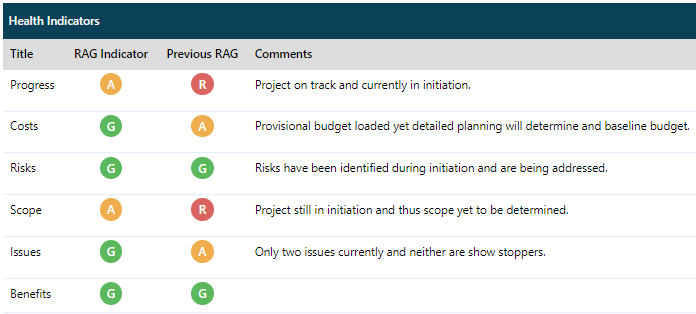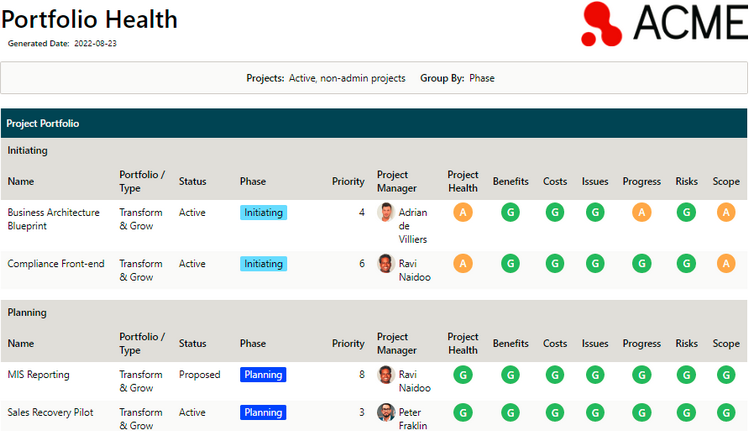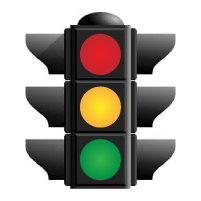 A PPO functionality that’s widely misunderstood (and misused) is the health indicators feature. The health indicators (also referred to as RAG, or red-amber-green indicators) are manually updated by the project manager and used primarily for project status reporting, aimed at measuring progress, identifying the need for corrective action, and for managing stakeholder expectations. If health indicators are not updated honestly, they can lead to issue avoidance and could hide serious problems around the health and progress of a project.
A PPO functionality that’s widely misunderstood (and misused) is the health indicators feature. The health indicators (also referred to as RAG, or red-amber-green indicators) are manually updated by the project manager and used primarily for project status reporting, aimed at measuring progress, identifying the need for corrective action, and for managing stakeholder expectations. If health indicators are not updated honestly, they can lead to issue avoidance and could hide serious problems around the health and progress of a project.
In this article, we are going to explore the use of PPO’s health indicators by looking at the most frequently asked questions.
What do the red, amber and green statuses mean?
The only way for health indicators to be effective is for the project management team to have a common understanding of what each colour indicates. This could differ from one organisation to another, but these are the recommended definitions:
GREEN: The identified aspect of the project is not at risk of negatively impacting the project and the project is performing according to the original business case or project initiation document. No corrective action or measures are required.
AMBER: A problem exists that may negatively impact the project’s objectives, but can be dealt with by the project manager and team. The project manager needs to bring the matter to the attention of the sponsor and senior stakeholders.
RED: Significant issues exist that require corrective action to ensure the project meets its objectives. The matter can no longer be handled only by the project manager or project team and requires support, guidance and assistance from the project sponsor and senior stakeholders. This aspect of the project is having a major impact on the health of the project.
How many do I need and which ones?
The health indicators should represent areas that could impact on the successful completion of the project, i.e. the critical items that could cause the project to either fail or not meet its objectives. These should include progress, costs and scope – as a minimum for good project management practices – but could also include other common project management areas like benefits, issues and risks.
My recommendation would be to track the following basic aspects:
- Benefits
- Issues
- Scope
- Risks
- Costs
- Progress
How do I indicate improvement or decline in each area?
The best way to track improvement or decline in each area is to keep track of the previous health indicator statuses. This would allow you to quickly see the status of each aspect as at the last update, compared to the current status.

Can I calculate the health indicators?
Based on the subjective nature of PPO’s health indicators, many users have asked whether they can change the health indicators into an objective, calculated measure. While this could be done technically, it would completely defeat the purpose of the health indicators.
The health indicators are meant to be a status update by the project manager which is visual (RAG) and focused on specific areas. It requires project managers to take responsibility for their projects, critically reviewing each area and indicating the health of that area based on their intimate understanding of the project and project management experience. If these indicators were calculated, the project manager will not have the opportunity to raise items they feel are under threat.
In addition, certain health indicators, such as quality and communication, are very difficult to determine with an objective calculation and require the project manager to provide subjective feedback to indicate the real status.
What is the relationship of these health indicators to the overall project health?
In PPO, every project is awarded one project health indicator. By default, this indicator shows the worst-case scenario of the underlying project health indicators, i.e. if one or more health indicators is red, the overall project health will show red; if one or more indicators is amber, but none are red, the overall project health will show amber; if all indicators are green, the overall project health will also be green.

When used correctly, the health indicators can add massive value to the day to day management of projects. By keeping the above descriptions, recommendations and explanations in mind, the mystery of health indicators should transform to a clearer view of how to track your project’s status.


